Bill Murray The Dead Don't Die
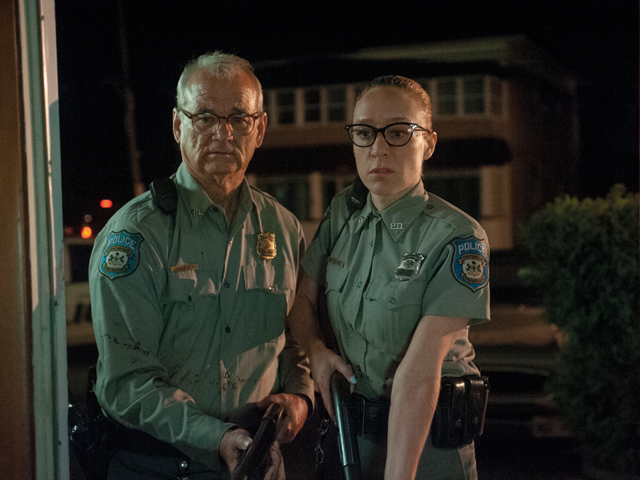
The peaceful town of Centerville finds itself battling a zombie horde as the dead start rising from their graves.
Cast: Tilda Swinton, Bill Murray, Adam Driver, Selena Gomez, Steve Buscemi, Danny Glover, Chloë Sevigny, Tom Waits, Caleb Landry Jones, Rosie Perez, Iggy Pop, Sara Driver, Carol Kane, RZA
Director: Jim Jarmusch
Genre: Comedy, Fantasy
Running Time: 105 minutes
Synopsis: In the sleepy small town of Centerville, something is not quite right. The moon hangs large and low in the sky, the hours of daylight are becoming unpredictable, and animals are beginning to exhibit unusual behaviors. No one quite knows why. News reports are scary and scientists are concerned. But no one foresees the strangest and most dangerous repercussion that will soon start plaguing Centerville: The Dead Don't Die " they rise from their graves and savagely attack and feast on the living, and the citizens of the town must battle for their survival.
The Dead Don't Die
Release Date: September 26th, 2019
About The Production
From Jim Jarmusch (Paterson, Gimme Danger, Only Lovers Left Alive) comes the writer-director's unique take on the zombie apocalypse, imbued with the deadpan tone and gentle comedy that has made him an iconic voice in independent filmmaking across the decades. Bringing together a multi-generational, multi-cultural cast and crew of familiar faces from productions past as well as new converts to the Jarmusch fold, including Danny Glover, Selena Gomez, Caleb Landry Jones, The Dead Don't Die is a family affair " a timely and at times poignant slice of life arriving at a crucial point in the American story, when it feels like the times we are living through are eating us alive.
The Dead Don't Die marks Jarmusch's tenth trip to the Croisette, having last appeared at the Cannes Film Festival in competition with Paterson in 2016, the same year he premiered Gimme Danger, a documentary on Iggy & The Stooges, out of competition. The filmmaker has been at Cannes with most of his previous features including Only Lovers Left Alive, Broken Flowers (winner of the Grand Jury Prize), Ghost Dog: The Way of the Samurai, Dead Man, Mystery Train, Down by Law, Stranger Than Paradise (winner of the Camera d'Or), and "Coffee and Cigarettes," which won the Best Short Film prize in 1993.
Bill Murray, Adam Driver and Chloë Sevigny star as police officers in the three-cop town of Centerville, forced into action when flesh-eating zombies invade their tiny hamlet. In this writer-director's hands, The Dead Don't Die is both gruesome bloodbath and droll metaphor for America's current predilection.
"The Dead Don't Die happens in a version of our world that's singular to this film, but that feels very expressive of the current moment," says producer Joshua Astrachan, who also worked on Paterson. "In Jim's narrative, the U.S. is conducting polar fracking, the earth has slipped off its axis, the ice caps have melted, the sun stays up during the night, the moon stays up during the day " and the dead start coming out of their graves."
Adding a poignant, comedic touch, Jarmusch's undead lurch back to life in search of a past hobby or fixation, capable of uttering only a single beseeching word. GRAMMY-winning country singer Sturgill Simpson, who composed the film's theme song, appears in a cameo as an undead musician, stalking the streets of Centerville with an acoustic-electric in tow, gutturally croaking "Guitar!"
"Pretty much all of humanity's zombiedom is here," says Tilda Swinton, who returns to the Jarmusch fold for the fourth time, playing scene-stealing Scottish-accented mortuary owner Zelda Winston. "We have cell phone zombies, fashion zombies, every kind of zombie imaginable. There are so many different ways of not being awake in our current climate " for Jim it's like shooting fish in a barrel."
Adds Larry Fessenden, the cult horror director (Depraved) and longtime Jarmusch compatriot, who appears in The Dead Don't Die as motel owner Danny Perkins: "Jim's movies always have this episodic quality, featuring people going through life trying to negotiate the peculiarity of the world. Add zombies to that and you get something deliciously whimsical"and quite nasty. There's violence almost to the point of insanity, another thing Jim has to say about humanity right now. But there's also this reserved melancholy, which has cropped up in his last couple of movies. I don't know if it's going to work out for the species, he seems to be saying; I don't know how we can fix this." 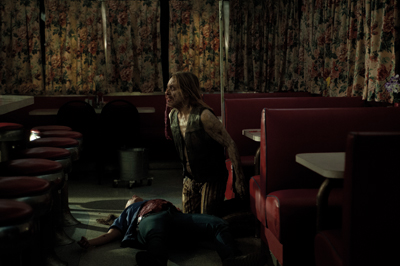 Zombie Apocalypse Now
Zombie Apocalypse Now
Jarmusch began thinking about writing a zombie movie some years back, before he shot Paterson, his meditative 2016 comedy-drama about a New Jersey bus-driver poet, played by Adam Driver. The writer-director is no stranger to subverting genre movies, having made a psychedelic western (Dead Man), a samurai/gangster mash-up (Ghost Dog: The Way of the Samurai), an existential action movie (The Limits of Control), a variation on the romantic comedy (Broken Flowers) and a bohemian vampire comedy set in Detroit and Tangier (Only Lovers Left Alive), also starring Swinton.
Jarmusch chose to place his creative stamp on a subject that has become ubiquitous in popular culture " no less than 55 zombie-related movies or TV shows were released in 2014 alone. "While vampires are seductive creatures, zombies in and of themselves, being sub-human, are not that interesting," says Jarmusch. "Every zombie story, however, is somehow metaphorical in the way that it depicts human conformity or some other tendency – walking entities without souls."
While making Gimme Danger, his 2016 documentary about Iggy and The Stooges (Iggy returns to the Jarmusch family in The Dead Don't Die playing a "coffee zombie"), the filmmaker and his producers noticed cell phone zombies on the streets of Miami as they were filming" oblivious pedestrians glued to their smartphones, sleepwalking across sidewalks and intersections. The vision took root as Jarmusch began writing in earnest following the simultaneous completion of Gimme Danger and Paterson, prompting the question " What if the undead came back to life craving the very things that preoccupied them in the living realm?
"We're all attached to things in the material world and we're all zombies in one form or another " it's not a huge stretch that we would yearn for those exact same things if we were re-animated," says Carter Logan, Jarmusch's longtime producer and SQÜRL band-mate, who collaborated with the Jarmusch on The Dead Don't Die's atmospheric score. "It's been a long time since Jim has deliberately written a "comedy", and while there is some kind of physical humor in the movie, it uses horror-genre conventions to laugh at the absurdity of our present times. This is Jim returning once again to genre filmmaking, turning the zombie movie on its head and creating his own unique vision for what the zombie comedy can be."
Adds Swinton: "All zombie movies are about human beings and that's why we love them " they're about catastrophe, with everybody feeling like they're on the brink and it can't get any worse, but then it does. That's what horror movies are for, and those of us who love zombie movies love them for that reason. It's good for us to imagine the undead " and then wake up in the morning and remember it was just a movie, or a bad dream."
Jarmusch's own taste in zombies extends to early classics from the horror canon, including 1932's White Zombie, starring Bela Lugosi as the white Haitian voodoo master Murder Legendre, who transforms a young woman into the living dead in what it considered the first zombie movie. He's also partial to I Walked With a Zombie, the 1943 b-movie from Jacques Tourneur featuring slave zombies on a remote Caribbean island who lack the willpower to do anything for themselves " an unsettling reflection of human life during a world war, echoing the fatalistic message of humanity's dead end in The Dead Don't Die.
But it's George Romero's 1968 shocker Night of the Living Dead that inspired Jarmusch the most during the writing and filming of his latest feature film. Careful viewers of The Dead Don't Die will spot numerous references and nods to the low-budget American horror classic, which has taken on a life of its own over the years, transforming from a down-and-dirty indie into everything from a social allegory for the Vietnam and Civil Rights eras to a metaphor for late capitalism and consumerism. The black-and-white original, made for $114K, also marked the first time zombies engaged in flesh eating on-screen, with terrifying socio-political implications. Tumultuous times are eating away at us once again.
"Night of the Living Dead is a brilliant film made with incredible limitations, and we quote the movie with many little details and references the careful viewer will recognize," says Jarmusch, singling out the 1968 Pontiac Le Mans driven by Selena Gomez in the movie, the exact same vehicle in Romero's debut down to its customized Palmetto Green paintjob. "In our film, as in Dawn of the Dead, Romero's sequel to Night of the Living Dead, the zombies return to places and things they were obsessed with as living creatures, trying to find that one thing they clung to while alive. I was intrigued by the idea of reanimated humans that function like single-celled organisms, cannibalistically feeding on flesh or brains but having no real will beyond that."
"On its surface, The Dead Don't Die is a zombie comedy, but there's a subtext underneath, not unlike Night of the Living Dead, a socio-political message, which I think is important right now," says Carter Logan. "We've been oversaturated with movies and TV shows that follow a certain formula " so much of the zombie genre lately verges on soap opera, with people trying to survive the zombie apocalypse. Our movie takes that into account, but this is Jim taking the zombie movie back to its most famous iteration. It's about humanity never losing its sense of humor despite great calamity in the world."
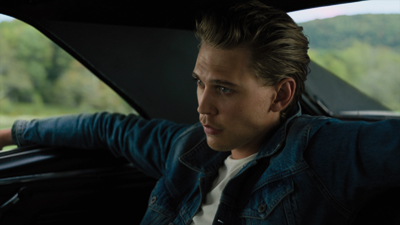 State Of The Nation
State Of The Nation
The Dead Don't Die is set in the tiny hamlet of Centerville, the proverbial three-cop town, isolated from the interstate, centering on a main street including a diner, hardware store, and motel, and containing a population of denizens brought to life with a uniquely Jarmuschian touch. "It's a small, town somewhere in unidentified, generic America," says Jarmusch, "and everybody knows each other. It's a fictional town, and the movie is about these divergent characters our story begins to follow around."
This form deviates from some of Jarmusch's other films, in which a central character, like Johnny Depp's accountant protagonist in Dead Man, or Bill Murray's soul-searching retiree in Broken Flowers, embarks on a solo odyssey across a surreal landscape, meeting other characters along the way. "While this one centers on the three police officers, we keep jumping around to other characters," says Jarmusch. "It became a little complicated in the editing room for that reason."
Jarmusch took the name Centerville from Frank Zappa's 1971 movie musical 200 Motels, another surrealist odyssey featuring the Mothers of Invention on tour in America, making a stop in the small town of Centerville ("A Real Nice Place to Raise Your Kids Up," Zappa wryly insists in the film), in the midst of going crazy from life on the road. Paying direct homage to Zappa's socio-political freak-out, Jarmusch made "A Real Nice Place" the tagline of his own Centerville, viewable on the town's welcome sign in the opening scenes of the film.
In The Dead Don't Die, the changing world visits small-town American life in increasingly surreal ways over the course of several days. Unbeknownst to Centerville residents, a human-caused cosmic event (related to hydraulic fracturing, the drilling of oil in the Arctic Circle " described by authorities in the movie as "polar fracking") has forced the earth's poles from their axis, disrupting the earth's rotation. With the sun refusing to set on its expected schedule, Chief of Police Cliff Robertson (Murray) and Deputy Ronnie Peterson (Driver) pay a visit to the woods outside Centerville to question cantankerous Hermit Bob (Tom Waits) about some missing farm animals belonging to the racist Farmer Miller (Steve Buscemi).
For the rest of Centerville, it's business as usual, as the world outside invisibly sputters towards its demise. Hardware store owner Hank Thompson (Glover) hangs out at the local diner, run by Fern – played by Eszter Balint, who appeared as the glib teenager Eva in Jarmusch's 1984 breakout Stranger Than Paradise. It's the first of many cameo appearances in The Dead Don't Die echoing the filmmaker's past works " even RZA, the de facto leader of Staten Island's Wu-Tang Clan, who produced the score for Jarmusch's Ghost Dog, and appeared in Coffee and Cigarettes, is on hand, playing (who else?) the local Wu-P.S. deliveryman.
Jarmusch's trademark underplayed comedy and eccentricity is on full display in The Dead Don't Die: Scottish-accented mortician Zelda Winston (Swinton) plays with samurai swords in her Buddhist-inflected lair when she isn't providing unusual high-fashion makeovers to newly dead corpses at the Ever After Funeral Home; a typically deadpan Bill Murray maintains law and order with a nudging wink in a storybook small-town whose singular renegade seems to be the ill-tempered Hermit Bob, a repository for some of the town's suspicions.
Jarmusch has frequently cast musicians in his works, and along with RZA and Tom Waits, he adds radiant, world-wide pop star, and actress Selena Gomez to his cast of oddballs in The Dead Don't Die, casting her as a young road-tripper who arrives in Centerville just in time for the zombie apocalypse. Jarmusch is an unexpected fan of Gomez's music, including her hit song "Bad Liar" (among others), which he hails as "undeniably masterful, groundbreaking pop music".
"I was imagining young, beautiful people on a road trip who end up by chance in Centerville," says Jarmusch. "I wanted to include different generations in the film and Selena, along with her travel companions Austin Butler and Luka Sabbat, represent the twenty-something age group."
While Gomez and her sidekicks symbolize unabashed freedom and abandon crashing into Centerville's staid and stubborn simplicity, another trio of young characters, played by newcomers Maya Delmont, Taliyah Whitaker, and Jahi Winston suggests something more sinister. Incarcerated minors stuck in the Centerville Detention Center, these young teenagers watch on television from their prison home as societal breakdown invades the country at large " and then Centerville in specific.
Balancing light comedy with a potent message about the plight of the young and different, Jarmusch holds palpable affection for the youngest characters in The Dead Don't Die. "I love teenagers, and I feel for them " young people have guided us culturally in music, style and fashion, whether it's Mary Shelley's Frankenstein, half of what Mozart wrote, or the work of Rimbaud, one of the greatest poets ever," says Jarmusch. "Teenagers typically have a rough time, so I wanted to have these three mixed-race teenagers in a detention facility. We never see them turn into zombies " for me they represent our hope for the future."
When night falls on Centerville, the zombie apocalypse suddenly erupts; local residents rise from their graves in search of creature comforts and human flesh, wreaking slow-motion havoc on the besieged, woefully unprepared human populace. One of the earliest zombies depicted is a mischievious town drunk, played by the national treasure Carol Kane, who Jarmusch was cast opposite in Alexandre Rockwell's 1992 feature In the Soup, also starring Steve Buscemi; Kane and Buscemi are two among many former Jarmusch collaborators who are welcomed back into the fold of his most expansive production yet.
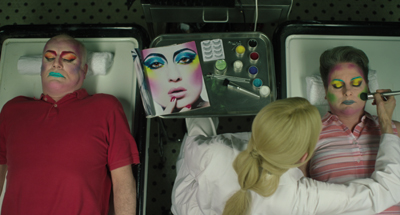 A Family Affair
A Family Affair
Jarmusch wrote many of the characters in The Dead Don't Die with specific friends and actors in mind, including the three Centerville police officers at the heart of the story, who are the closest things to central protagonists in an ensemble production comprising a cast of dozens.
"Jim likes to create a family of people, cast and crew, and then foster that spirit during the making of the film," says Carter Logan. "He reaches out to actors he has in mind for specific roles, which makes things go faster in certain ways. He doesn't need to spend weeks in rehearsal."
Bill Murray has worked with Jarmusch no less three times previously, on Broken Flowers, The Limits of Control, and Coffee and Cigarettes. In a wry twist on his philandering character's name in Broken Flowers " which was Don Johnston " Jarmusch this time around opted to christen his lead cop Cliff Robertson, after another Hollywood star.
"I was excited when I got the script, which was quite funny " I didn't know Jim could write comedy in this mold," says Murray. "Having already appeared in what I consider to be the greatest zombie movie of all time, Zombieland, I felt like The Dead Don't Die could almost typecast me. Maybe I'll become synonymous with the zombie horror genre!"
Also returning to the Jarmusch family is Adam Driver, fresh from his lead role in the filmmaker's previous feature, Paterson. While filming the poetry-themed comedy, the actor and director joked about someday making an action movie called Peterson, featuring a violent, sociopathic character, in wild contrast to Paterson's pensive, poetic protagonist. When Jarmusch wrote The Dead Don't Die with Driver in mind for Centerville's stone-faced second-in-command, he immediately christened his character Peterson.
Chloë Sevigny appeared in Jarmusch's Broken Flowers after initially working with the director on his segment of the 2002 short film omnibus Ten Minutes Older, entitled "Int. Trailer. Night." As mild-mannered officer Mindy Morrison in The Dead Don't Die, Sevigny swaps out her familiar tough, worldly insouciance for something demure and often times hysterical. "She's the only character you see in the movie that's really being affected by the zombie apocalypse " she's traumatized," says Sevigny. "When I sat down with Jim to go over the script, he could tell I thought she wasn't a very strong woman. He told me there were already a lot of strong women in the movie, and I was going to be the Scream Queen. I knew I was going to have to take one for the team."
Tilda Swinton return to the Jarmusch stable for the fourth time, after starring in Only Lovers Left Alive, the writer-director's elegant, world-weary vampire movie from 2013, co-starring Tom Hiddleston. Jarmusch reached out to Swinton early on in the writing phase and asked the shape-shifting, globe-hopping actor what kind of character she wanted to play. "I told him I wanted to play this mortician who is out of sorts because, as the title indicates, the dead don't die," says Swinton. "I proposed it, and 18 months later he sent me the script."
As Zelda Winston, Swinton cuts a glamorous swath through middle-of-the-road Centerville, sporting a thick Scottish accent, flowing white-blond hair, a series of florid kimonos, and a samurai-sword fixation that comes in handy during the beheadings that arrive fast and furious in the film's garish second half. "Nobody knows much about Zelda, or where she comes from," says Swinton. "There's a moment in the movie when her strangeness is being discussed and it's declared that she's Scottish, which is rather exotic for the people in Centerville. There's a mystery about her " amongst all these weirdos, she's a different kind of weirdo."
Rounding out the cast of returning Jarmusch veterans is Steve Buscemi, who appears in The Dead Don't Die as the racist Farmer Miller, having first worked with Jarmusch back in 1989 on his Memphis hotel triptych Mystery Train, starring opposite Joe Strummer. Buscemi and Jarmusch have known each other since the late '70s, when Jarmusch was an NYU film student preparing to direct his debut feature, Permanent Vacation, and Buscemi was a struggling actor yet to break out in independent film.
Says Jarmusch of one of his oldest colleagues and friends, who in the movie sports a red ball-cap bearing the words Keep America White Again: "I wrote the Farmer Miller character as incredibly racist and narrow minded " because Steve is the least racist and narrow minded person I know."
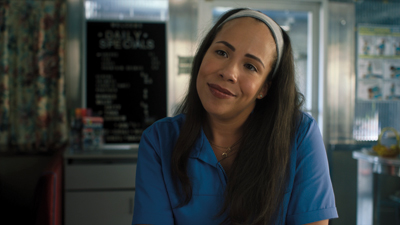 Day For Night
Day For Night
Like the actors, many crewmembers who worked with Jarmusch in previous capacities return to The Dead Don't Die with new or expanded roles. Alex DiGerlando, who began his career in the art department on Broken Flowers, eventually designing the first season of HBO's "True Detective," takes on the mantle of production designer of Centerville and its environs; makeup department head Judy Chin and costume designer Catherine George both share a rich, illustrious history with the filmmaker, with Chin's work dating back to Ghost Dog and George's work " before she designed the costumes for Paterson " going back to Coffee and Cigarettes, where she served as Cate Blanchett's wardrobe supervisor; sound mixer Drew Kunin has worked with Jarmusch since 1984, when he handled sound on Stranger Than Paradise.
Frequent Jarmusch cinematographer Frederick Elmes, who shot Eraserhead and Blue Velvet for David Lynch, among dozens of classic films, returns to the Jarmusch family having previously shot Paterson, Broken Flowers, Night on Earth, as well as a large percentage of Coffee and Cigarettes, including the short film "Somewhere in California."
"Fred is one of our greatest living cinematographers, extremely focused and innovative, with simple, beautiful ways of enhancing what appears on screen," says Jarmusch. "We've worked together for a long time " he's been my teacher in so many ways in terms of how you make a film."
Elmes opted to shoot much of the movie "day for night" - cinematic parlance for simulating night scenes while filming in daylight, a throwback to micro-budget filmmaking in the style of Night of the Living Dead. Thus most of the nocturnal scenes in the film " including many of the zombie apocalypse scenes " were shot in daylight and manipulated in post-production to resemble darkness.
Elmes' crafty approach to troubleshooting " coming from decades in the business dating back to the 1970s, when he made short films with David Lynch " came in handy for several interior car sequences, in particular the Pontiac Le Mans scenes featuring Selena Gomez and her travel companions, and the police car scenes including officers Robertson, Peterson and Morrison. Indeed, most of the driving scenes in The Dead Don't Die were shot indoors on a soundstage, with actors looking through the car windshield at blank warehouses' interior as the cameras rolled. Elmes and the incredible VFX team digitally inserted exterior footage during post-production, a meticulous process.
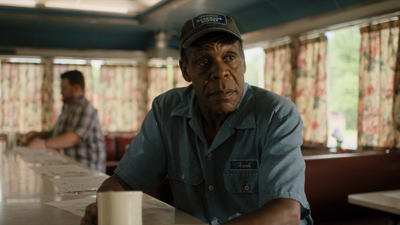 Bringing The Undead To Life
Bringing The Undead To Life
The biggest challenge for Jarmusch in making his latest feature was working with special effects " practical and digital " to create the film's elaborate yet intentionally old-fashioned zombie creatures. Notoriously minimalist in his approach to filmmaking, The Dead Don't Die marks the seasoned director's first foray into the world of prosthetic makeup, VFX, practical effects (including silicone organs and viscera) used to make the film's many throat-slashings and decapitations come to life more effectively in the post-production phase.
"Everyone has seen 'The Walking Dead', so there's a certain kind of bar that has been set in terms of what a zombie should be in this day and age," says production designer Alex DiGerlando. "We came up with a version of the zombie that's not quite as grotesque and severe " something that has one foot in the grave of earlier zombie classics, including Night of the Living Dead."
"Kill the Head," a recurring line of dialogue in The Dead Don't Die, becomes a mantra for several characters as they discover that the only effective means of annihilating the undead is through violent decapitation. In one of the movie's most memorable scenes, Swinton lops off several zombie heads in rapid succession with her katana sword, elegantly sashaying through the streets of Centerville in a billowing kimono, designed by frequent Swinton collaborator Catherine George. Heads don't simply roll in The Dead Don't Die " they dislodge and erupt, revealing a mysterious black dust.
"I wanted one thing in particular for our zombies " to be bloodless and fluidless," says Jarmusch. "When they get decapitated, they're just dark dust inside."
The filmmaker was adamant about not making a bloodbath in the style of Tom Savini, the so-called Sultan of Splatter, whose prosthetic makeup and spurting geysers of blood became signatures in the '70s and '80s films of George Romero, Tobe Hooper and Dario Argento. For his own practical effects, including prosthetic makeup, Jarmusch turned to the New Jersey effects house Prosthetic Renaissance, whose work has appeared in Black Swan and The Wrestler and several films by Martin Scorsese.
For visual effects work, including the beheadings, Jarmusch turned to VFX Supervisors Alex Hansson and Sam O'Hare from Chimney, a VFX house with offices around the world, including Los Angeles, New York and Gothenberg, Sweden. Most recently, Chimney contributed VFX to Atomic Blonde, including a 10-minute fight sequence featuring Charlize Theron battling multiple enemies in close quarters.
Stunt coordinator Manny Sivero " another veteran of several Jarmusch productions " choreographed the battle and decapitation scenes, using practical effects (including severed heads) made by Prosthetic Renaissance, which were captured on film as lopped-off heads hitting the ground. These shots required meticulous coordination to match later shots enhanced by VFX in post-production.
During pre-production, Prosthetic Renaissance fashioned busts from the heads of actors including Chloë Sevigny and Carol Kane. Lacking time to make a bust of Selena Gomez, the team, represented by company founder Mike Marino and key artist Mike Fontaine, devised a way to use prosthetic makeup on the actor's neck to create a ripped-open throat. Using VFX in post-production, the Chimney team digitally removed Gomez's body. Leaving only her head " appearing severed in a scene in which Adam Driver dangles it in the air -- while Gomez's eyelids briefly flutter after her decapitation.
"What's cool about The Dead Don't Die is there's a real intersection between the computer effects and the practical effects and the makeup and costumes," says DiGerlando. "It was fun figuring out how they all jigsaw together, creating a larger picture and mood for the film than what's written in the script." 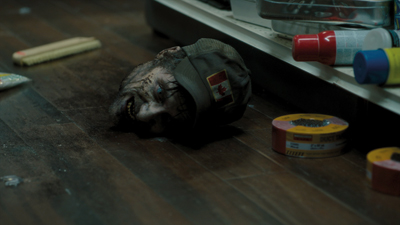 Anatomy Of A Scene: Coffee!
Anatomy Of A Scene: Coffee!
The first zombies on screen in The Dead Don't Die are "coffee zombies," played by longtime Jarmusch collaborators Iggy Pop and Sara Driver (Boom For Real: The Late Teenage Years of Jean-Michel Basquiat).
Jarmusch's budget could not accommodate an entire cast of meticulously made-over zombies, forcing the filmmaker to reserve specific looks for bigger players like Pop and Driver; many zombies in the film wear simpler suggestive makeup applied by department head Judy Chin and her team, and period-specific costumes by Catherine George.
"I had to decide on a case by case basis which zombies required prosthetic makeup and which did not, but the idea was to have a blend, using the simplicity of Night of the Living Dead as my guide," says Jarmusch. "It's a mixture partly by choice and partly by economic limitation."
As the coffee zombies rise from their graves in the Centerville cemetery " with Driver in high heeled boots and a disheveled bouffant and Pop wearing a leather vest and striped velvet bellbottoms" George's meticulous costume work is showcased: She modeled the couple's retro look after Keith Richards and Anita Pallenberg, the ultimate rock & roll couple at the dawn of the '70s. Prior to filming, George had both actors' costumes treated by a breakdown artist using paint, dirt and sandpaper to create a worn, earthen look for the zombie costumes.
"Catherine's work plays a big role in helping us feel like every one of the undead is a specific single person " I don't know if any film has tried this before," says Joshua Astrachan. "You feel like these zombies are individuals, coming out of the grave from distinct times and eras. It's poignant."
Continuing the process, hairstylist Jasen Sica kept Iggy Pop's hair mostly untouched, gunking it up with product in order to keep his iconic silhouette recognizable. Using hair conditioner and dust powder (essentially dirt), he transformed Driver into a dirty blonde bombshell circa 1972, adding a period-specific bouffant modeled on Brigitte Bardot. "I wanted her to look pretty," says Sica, "but I didn't want her to look like a mess."
As the doomed lovers stumble towards the Centerville Diner in search of caffeine and human flesh, the work of Chin and her makeup team, in collaboration with Marino and Fontaine from Prosthetic Renaissance, comes to ghoulish light. "Jim wanted to go back to the old Hollywood version of the zombie, staying away from the intense-looking creatures on shows like 'The Walking Dead,'" says Chin. "He's right when he insists that the zombies from Night of the Living Dead are scarier than any other movie " if you look closely at extras in background scenes, some of them don't wear any makeup at all. But they're terrifying! Makeup doesn't always have to be gory or crazy-looking to be scary."
Adds Mike Marino: "Jim typically doesn't use heavy effects in his movies, so going down the path of practical effects and horror makeup was a first for him. With effects movies, you need heavy planning and a lot of pre-production work. He was relying on us to help him understand how to pull things off."
Opting against prosthetic makeup for Iggy Pop, the makeup team paled out his skin to bring out his bone structure, organically decaying his face in order to keep his features recognizable. "He has an incredible face and skull," says Marino. "He didn't require much beyond paint on his face, in addition to some veining and crusting effects. This kind of dialed-down zombie you could only do on someone like Iggy Pop."
Sara Driver's makeup strategy was even more simple, using organic colors and textures and various glazing gels and sprays to keep her retro beauty intact. "Sara's character died in the early '70s, so we played with blue eye shadow and false eyelashes, naturally sculpting her features in a broken-up, crackled way," says Chin. "I added a little blossom of color on her cheeks to shape her cheekbones." For rotting teeth, Chin turned to a company called Mouth Effects, specializing in oral enhancements.
Pop's imposing physicality was made rigid and unsettling in the scene through a full-body latex airbrushing courtesy of Mike Fontaine, who sprayed the performer's body from head to toe, requiring Pop to sit motionless in the makeup trailer with his arms in the air for long stretches of time. Explains Pop of the process: "Jim told the makeup department, 'Iggy looks too healthy to be a zombie, you need to rough him up. They swoop in and surround you like a coven, covering you with makeup for an hour or two in the chair. Then comes the latex spray paint and you start to feel like a character in an Edgar Allan Poe story. There's gunk in your hair and eyes, crud on your clothing, fake blood everywhere."
Prior to production, the Prosthetic Renaissance team held several meetings on the subject of flesh eating " specifically what materials they could use to replicate the effect of zombies eating human body parts on camera. Says Mike Marino" "Jim wanted to show Iggy chewing on intestines, so we arrived on set with a water cooler stuffed with real sausage, along with barbecue sauce for blood and soft banana chunks resembling fatty flesh "this was in 100 degree weather, mind you."
Driver eats the flesh of a diner employee played by Eszter Balint, who appeared in Stranger Than Paradise in 1984, which Driver, then in her mid-20s, had produced. During filming, the ghoulish scene stretched out for what seemed like an eternity, with Driver eating fake guts out of Balint's ravaged corpse, tailor made by the Prosthetic Renaissance team. "Jim didn't call cut, so I kept eating poor Eszter," says Driver. 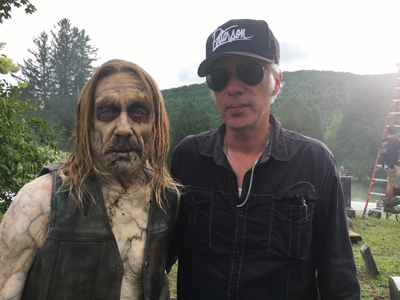 A Flurry Of Zombies
A Flurry Of Zombies
Turning out Pop and Driver for the first big zombie scene in The Dead Don't Die was one thing " the zombie apocalypse was something else altogether. As the film progresses into a full-blown eruption of the undead, the makeup, hair and costume teams had their work cut out for them, requiring close coordination and cooperation as they feverishly styled and dressed multiple zombies in rapid succession.
"There were days when we had 20 people getting made up in the makeup trailer at once, it was intense," says Fontaine. "We were using a lot of layering material, including paint, but we found shortcuts for creating the black crust effects Jim wanted, including coffee grounds mixed with glue, using paintbrushes to lather it thick across the actors' bodies and faces."
Adds Marino: "It was a challenge coordinating how many zombies we could get ready in a short window of time, becoming like a game of push and pull " we were trying to give Jim what he wanted, quickly, while working as hard as we could to make the zombies look good aesthetically."
Working with scores of extras, each of whom had to be quickly zombified in an assembly-line process, alongside many in the central cast, Judy Chin and her staff of three assistants were tasked with turning out dozens of looks to be filmed in the punishing summer heat " when makeup is stubbornly resistant to human skin.
"If you're not a real painter, it's a challenge to make someone look organically dead," says Chin. "It seems like something that would be easy to do " hollowing out the eyes and the cheekbones and painting the face to make the actor look gaunt and dead. But it's hard to make someone over using just paint to shape the contours of their bone structure, without making it look like a contour. Our job was to make the zombies look like a makeup artist hadn't been there."
Finding Centerville
The Dead Don't Die filmed in Upstate New York during July and August of 2018. Prior to production, location manager Jeff Brown met with Jarmusch and Alex DiGerlando to find a location for Centerville that was reasonably close to New York City " but could also serve as the proverbial three-cop town.
"We were looking for a town that was both graphic and specific, something that stood out immediately", says Brown. "We had to know right away that a location was a police station or a motel. "
After two weeks of scouting and finding nothing suitable in the leafy, tony suburbs of nearby Rockland and Westchester counties, Brown and his team canvassed the next round of counties hoping to find something more quaint and rural.
"If there were buildings over three stories, that would kill the town for us," says Brown. "If it was too built up, or modern, with chain stores in the vicinity, it wouldn't work at all."
At the suggestion of the Hudson Valley Film Commission, they combed Ulster, Delaware, Dutchess, Sullivan, Greene and Orange counties, many of which contained small villages and rural farmland. With help from the HVFC and Google Maps, the locations team narrowed it down to 15 towns.
On a subsequent scout, with Jarmusch, Brown, Elmes, DiGerlando and producer Carter Logan in attendance, the team came upon the village of Fleischmanns, located near Middletown in predominantly mountainous Delaware County, containing a population of only 322 people. The last film production to shoot there was the Christian Slater-starring indie Julian Po, which wrapped in 1997. The small village, located in the Catskills, 20 miles outside Woodstock and far from any interstate, was eager to accommodate the modest-sized production.
"In the script, Centerville is a small town with a diner, a hardware store and a police station but there aren't that many towns left that are as small and quaint as we needed ours to be," says Brown. "The village of Fleischmanns worked for us because it has a main street with businesses and storefronts, but also houses opening up into farmland beyond."
The small downtown area made it easy to control the zombies as they walk around in great numbers toward the end of the film, and assorted buildings in the vicinity of the village's main drag included a police station (created by the production in an empty storefront), motel, and farm. Apart from the diner scenes and gas station, the filmmakers had found almost everything they required, location-wise, in one small village in Delaware County. Best of all, Fleischmanns and its environs held a population of local residents who were willing and eager to be made up as zombie extras in the punishing August heat.
With the location secured, DiGerlando built interiors for the funeral home where Swinton's Zelda Winston embalms corpses and practices martial arts, in a strange cross between a Victorian house and a pan-Asian house of worship. He built Hank Thompson's hardware store from scratch, packing intricate details into a small space for a key scene in which zombies attack Danny Glover and Caleb Landry Jones, barricaded inside.
Set decorator Kendall Anderson combed the region for hardware stores that were going out of business so the production could buy up liquidated inventory and create a meticulous replica of a small-town hardware store.
Also built from scratch was the police-station interior, containing three desks and two very anachronistic-looking jail cells, one of which accommodates Carol Kane in a memorable scene before she is decapitated.
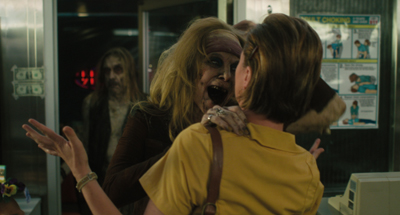 Ghosts Inside A Dream
Ghosts Inside A Dream
While the film is intended to be fully left to the viewer's own interpretation, those looking for an overarching theme in The Dead Don't Die might look at the movie's indelible and rueful title song, written by GRAMMY-winning country singer Sturgill Simpson, whose evocative and melancholy lyrics echo the story at large, and the American story in particular as it is plays out in these unnerving times.
It's a song about apathy, indifference and impermanence in a rapidly changing world, as characters grapple with dwindling freedoms and free will, as though each of us were zombies lurching toward creature comforts from our past. "There's a cup of coffee waiting on every corner," laments Simpson in the song. "Someday we're gonna wake up and find the corner's gone."
Jarmusch, a true Simpson fan dating back to the singer-songwriter's 2013 debut album, High Top Mountain, reached out to the prolific performer early on in his writing process, wanting a song that could be played repeatedly in the film to underscore the story's larger themes. Among other references, the hipster characters, led by Selena Gomez, are seen purchasing a CD copy of the song from convenience-store clerk Caleb Landry Jones, while Adam Driver's Ronald Peterson name-checks the track during a drive through Centerville with Police Chief Robertson.
Jarmusch's sole request of the songwriter, after sending him the script, was that the song was conceived in the classic-country mid-century style, bearing the title of the screenplay he had written. "'The Dead Don't Die' is a beautiful jewel of a song, as though it was made in 1961 and somehow got lost in the cracks of history," says Jarmusch, whose band SQÜRL provides the film's atmospheric non-diegetic score. "It's the only source music in the entire film, and we hear the song in part about five or six times over the course of the movie."
Simpson's poignantly evocative song, with its classic country instrumentation and heartfelt vocals, underlines the ephemeral nature of our lives, and implores us to wake up and pay attention to the details around us. "There'll be old friends walking 'round in a somewhat familiar town," Simpson concludes, "that you once saw when you looked up from your phone."
The Dead Don't Die
Release Date: September 26th, 2019
MORE



